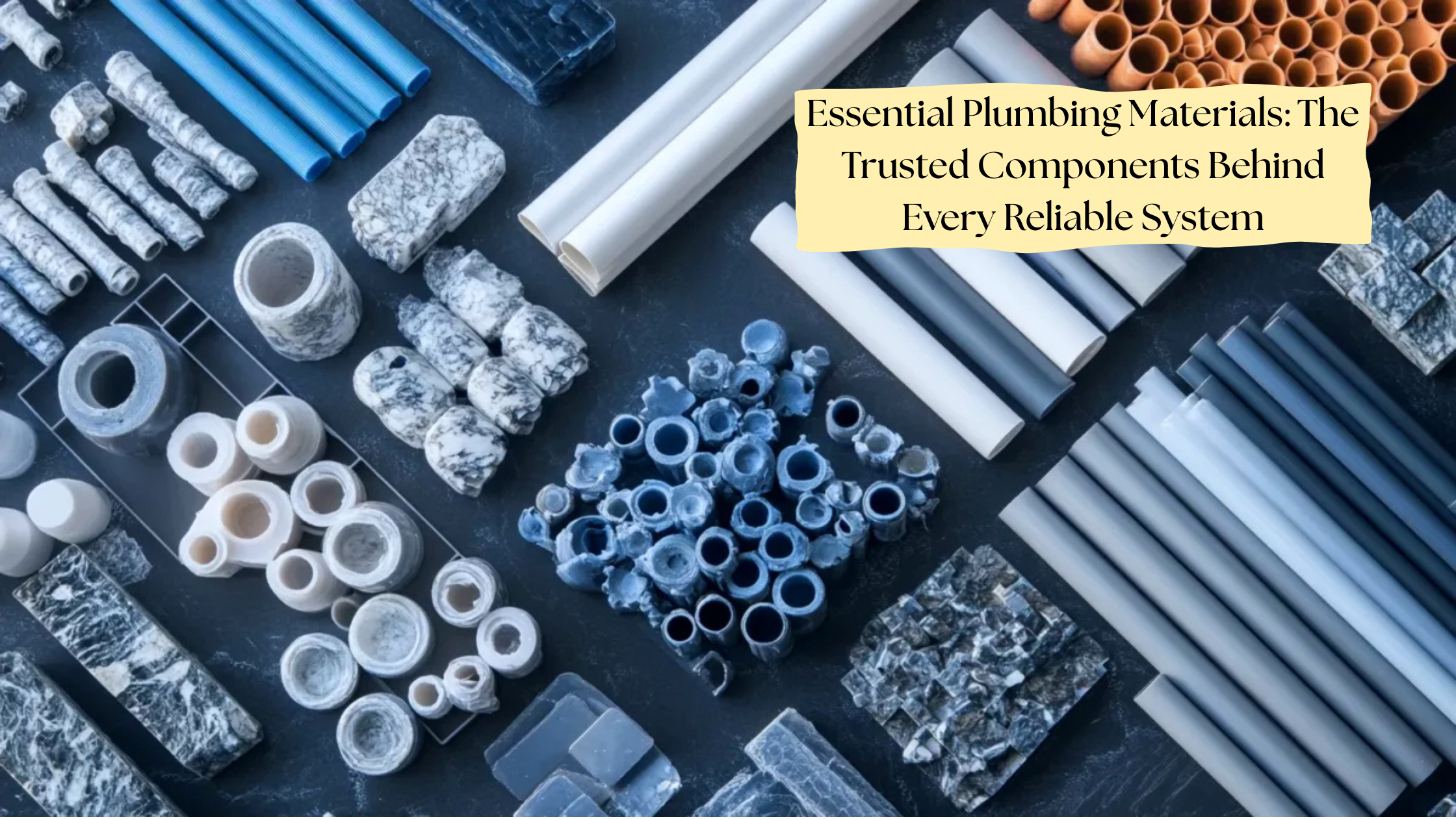When considering a well-established home or building, lighting, ventilation, and even aesthetics always cross our minds. But one of the most important yet overlooked systems working behind the scenes is plumbing. At its foundation, plumbing relies on materials—the pipes and fittings—whereby water flows smoothly and waste is channeled safely away.
As of 2025, plumbing materials have become so diverse, each with certain strengths, weaknesses, and best applications. If you’re building a new home, replacing your current system, or simply interested in what’s behind those walls, knowing about plumbing materials gives you better-informed decisions.
What Are Plumbing Materials, Really?
Plumbing materials are pipes and fittings intended to carry fresh water, wastewater, or gas in residential, commercial, and industrial structures. These materials constitute the framework for:
- Supplying potable drinking water
- Disposal of wastewater
- Delivering gas to appliances
- Supplying irrigation and sprinkler systems
Effective material selection guarantees efficiency, durability, safety, and economic viability. Let’s proceed to discuss the principal types of plumbing materials utilized in construction today.
1. Copper Pipes: Durable and Sanitary
Copper pipes have long been considered the gold standard in plumbing—particularly for drinking water supply. Whether you’re running hot or cold water, copper performs reliably. Its resistance to corrosion and inability to absorb external contaminants make it ideal for clean water delivery.
One of copper’s greatest advantages is durability. These pipes often last decades, and when maintained, can function without issue for over 50 years. Copper also has the added bonus of being recyclable, which makes it a more eco-conscious option.
But copper is not inexpensive. It is one of the pricier options and typically needs to be installed by a professional plumber who has soldering skills. Even with the price, though, most like it for its longevity and safety.
2. PVC Pipes: Lightweight and Pocketbook-Friendly
Polyvinyl chloride (PVC) piping is widely used in drainage, cold water supply, and irrigation systems. It is everybody’s favorite due to its light weight, ease of use, and rust or corrosion resistance.
Homes usually resort to PVC for outdoor plumbing jobs and non-pressurized systems. It exists in two general forms: Schedule 40 (standard) and Schedule 80 (thicker and stronger).
Nevertheless, PVC has its limitations. It’s not appropriate for use with hot water systems and will deteriorate when left out in the sun for extensive periods. Despite that, it’s a useful option for DIY work and budget-friendly projects.
3. CPVC Pipes: A Hardened Upgrade for Hot Water
Chlorinated polyvinyl chloride, or CPVC, is an improved PVC that is capable of accommodating hot and cold water supply. CPVC is temperature-resistant to 93°C, making it suitable for household water pipes where heat is a requirement.
CPVC is chemically and corrosion resistant, lasts 50–75 years, and is relatively simple to install—by anyone, not just professionals. While a bit more expensive than PVC, it’s still much less expensive and easier to handle than copper, so it’s a popular choice among today’s contractors.
4. PEX Pipes: Flexible and Convenient
PEX (cross-linked polyethylene) is one of the most sought-after plumbing materials for new constructions. It is so flexible that it bends around corners and minimizes fittings and joints. This speeds up installation as well as saves costs.
PEX is hot-water and cold-water compatible, red pipes being used for hot water lines and blue for cold. It does, however, have some limitations: it cannot be out in the sunshine, so outdoor application is not recommended. Also, PEX is not recyclable, something that might concern sustainability-conscious homeowners.
5. ABS Pipes: Cold-Climate Friendly and Simple
Acrylonitrile Butadiene Styrene (ABS) pipes are commonly applied to underground drain and vent systems. They’re much like PVC, except that they’re more resilient in cold climates.
These are simple to connect, fairly light in weight, and can easily be buried underground. There are building codes, though, that limit their use, so it’s always advisable to verify what local government regulations are prior to choosing ABS. Joint integrity can also occasionally become problematic if not sealed properly.
6. Galvanized and Cast Iron: Legacy Materials Still in Use
In older residences, you may still have galvanized iron or cast iron plumbing.
Galvanized pipes consist of iron or steel coated with zinc to avoid rusting. They used to be very common for water supply but have since been phased out because of problems such as internal corrosion, which can lower water pressure and quality.
Cast iron, however, is still occasionally utilized in drainage and vent applications, especially in commercial or multi-story buildings. It is very strong and long-lasting, with great soundproofing capabilities. It is heavy and cumbersome to install, however, and thus not as prevalent in contemporary residential plumbing.
Selecting the Proper Material for Your Plumbing Application
Your plumbing material choice is based on a number of things:
- Type of application: Is it for hot water, cold water, gas, or drainage?
- Budget: Some materials are much more expensive than others
- Installation complexity: DIY or professional-only
- Longevity: Will the material be enduring for decades or require premature replacement?
- Environmental conditions: Will the pipes be subject to sun, freezing, or corrosive conditions?
Every material has its own advantages, and there is no one-size-fits-all solution. In many cases, a mix of materials is employed in a single plumbing system to cost-optimize, high-perform, and be long-lasting.
Conclusion: Why Plumbing Materials Matter More Than You Think
Behind every properly functioning faucet, flush, or garden sprinkler is a well-researched selection of plumbing components. These unheralded heroes not only make your home work so well but also ensure your system is safe, efficient, and long-lived.
In a world where we value sustainability, performance, and long-term savings more and more each day, the choice of plumbing material goes beyond being a technical option—it’s a wise investment in your property’s future. Whether you’re constructing from the ground up or just replacing aging pipes, understanding your choices empowers you to make wiser, more confident decisions.

